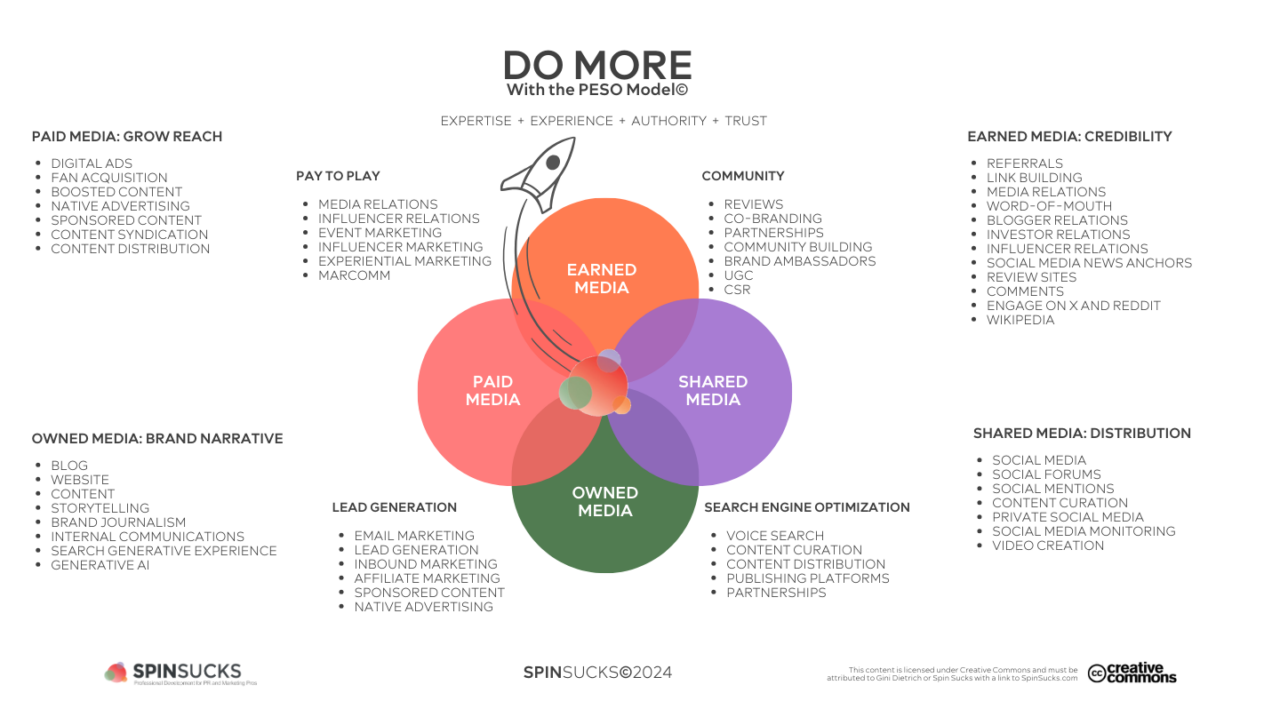Something has struck me as I’ve been talking to prospective clients recently.
It seems as though a fair number of companies are relying on social media to get the word out about their news.
As we discuss adding PR to their efforts, I’m surprised to learn that they’ve been using social media as their primary public relations platform.
Social media has its place – but relying on it as your public relations arm is a mistake.
Given this, let’s examine how social media and PR differ and how they can work together to maximize a company’s communication efforts.
How Social Media and PR Differ
Both social media and public relations help companies get the word out about their news and stories. But, they aren’t the same.
To illustrate this, look above at the diagram developed by Gini Dietrich of Spin Sucks. It’s called the PESO Model. PESO stands for Paid, Earned, Shared and Owned media.
I often refer to this model when talking with prospective B2B PR clients or speaking at events to help people visualize how these different types of media fit together.
If we look at social media in the diagram (it falls under Shared Media), we’ll see that one of its primary roles is distributing a brand’s messages.
Now, let’s look at public relations – or media relations, as many might call it. It falls under Earned Media. It’s about building credibility through media relations and other initiatives.
If a company relies on social media to build credibility without a true PR effort underlying this focus, it could be missing the mark.
Building Trust with Your Audience Is PR’s Role
Engaging in public relations helps a brand build trust with its audiences. If your audience follows you on social media – AND reads your blog posts and contributed articles – that adds to your credibility and can motivate them to learn more about you – and eventually buy from you.
We should also touch on Owned Media in this discussion. The content you publish on your site falls under this category. It includes customer success stories, case studies, blog posts, thought leadership pieces, and so on. (A note here to publish your press releases in a “press” or “news” area on your site, as reporters may also review those.)
If you want to hit it out of the park, you can focus on building the content on your site first. Then, add earned media/PR to this to help bring more visibility to your content. Next, leverage shared/social media to get even more attention for your media hits.
On top of all that, adding Paid Media to the mix can garner even more attention for anything you’ve shared.
Where to Start with Earned, Shared, Owned and Paid Media
Now, we know not every company has the team or budget to undertake ALL these initiatives, so, during an episode of PR Explored, I talked with Gini Dietrich about the order in which she recommends pursuing the four pillars of the PESO Model.
While every situation is unique, Dietrich recommends starting with owned media. Why?
“Because, without content, you have nothing to share on social media, nothing to prove your expertise for earned media, and nothing to boost for paid media,” Dietrich explains.
I agree. The foundation of a powerful PR program is owned media (= content).
Some companies may have no one with the time or talent to write content – or they may not know what to write about.
But – and hear me out – if you’re able to attract a journalist’s attention through media pitching, one of the first things they’ll do is visit your site. If the proof isn’t there in your content, it may be reason enough for them to move on to the next potential source on their list.
Or, say a prospective client sees a story about your company in the news and wants to learn more, so they visit your site. If the content to support what they’ve already read isn’t there, an opportunity may be missed.
Using Social Media to Amplify Earned Media
So, what if you are engaging in a media relations push, and your efforts are yielding results in the form of media coverage? Be sure to share that on social media. Sharing your media coverage on social media helps it get more attention. By connecting the two, you can get so much more out of both.
It’s wise to tag the reporter and the publication when you share a story. It’s good manners – and it helps them out. After all, the more attention a story gets, the more likely the reporter may be to write about that same topic again in the future. Who knows, they may even feature your brand again.
Public Relations and Social Media Work Better TOGETHER
If you’re expecting social media alone to do the work of PR, it’s time to think again.
If launching a full-scale public relations program seems overwhelming, it’s OK to start small. Talking with a consultant may help you determine where to focus your efforts.
Are you a small business in need of help adding PR to your marketing mix? Contact me to discuss a B2B PR plan.
Learn more about my PR consulting services here. Book a no-obligation call to talk about your needs here.
About the author: Michelle Garrett is a B2B PR consultant and author of B2B PR That Gets Results. She helps companies create content, earn media coverage, and position themselves as thought leaders in their industry. Michelle’s articles have been featured by Entrepreneur, Content Marketing Institute, Muck Rack and Ragan’s PR Daily, among others. She’s a frequent speaker on public relations and content. Michelle has been repeatedly ranked among the top ten most influential PR professionals.
100% of this blog post was written by me, the human.
Featured image is courtesy of Spin Sucks, www.spinsucks.com, used under Creative Commons.

